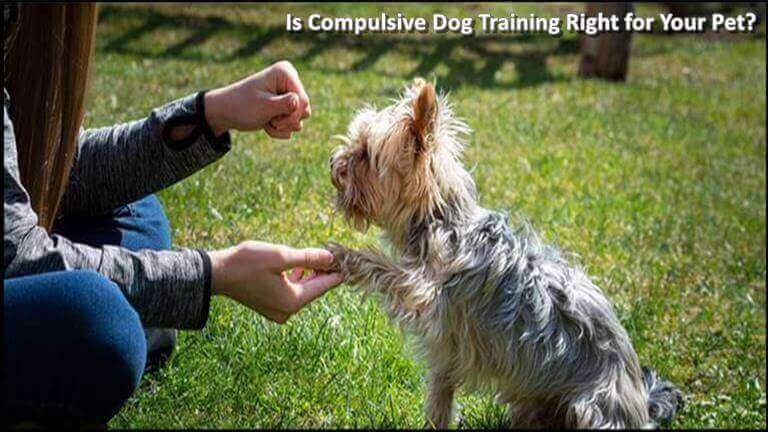Compulsive dog training is a type of dog training that relies solely on the use of repetitious rules, commands, and rewards to condition a dog’s behavior. Compulsive Dog Training and Compulsion Dog Training are considered to be the same thing. The idea behind this training is to train a dog to obey commands and act in a predetermined way all the time.
Many dog owners wonder if compulsive training is a good way to train a dog. However, before we answer that question, let’s first take a closer look at what exactly this training involves.
Types of Compulsive Dog Training
When it comes to compulsive dog training, there are several types to use it. Some common techniques are
- Positive Reinforcement
- Negative Reinforcement
- Shaping
- Clicker Training
Positive reinforcement is a training method that uses rewards such as treats, verbal praise, and petting to reinforce desirable behaviors in dogs. By rewarding desired behaviors, positive reinforcement can effectively train dogs while also strengthening the bond between the dog and trainer. It is a gentle and effective training method that avoids the use of harsh punishments or physical force.
Negative reinforcement, on the other hand, involves withholding rewards like treats and verbal praise to discourage undesirable behavior. You can learn about this in detail in our other blog “The Benefits of Operant Conditioning in Labrador Training”
Shaping is a training technique that involves breaking down new behaviors into small, achievable steps. By rewarding dogs for each step, they can gradually learn the behavior. For example, to teach a dog to “sit pretty”, the trainer might first reward the dog for lifting its front paws off the ground, then gradually extending the time they can hold the position. Shaping makes learning easier for dogs by breaking down behaviors into small steps.
Clicker training is a reward-based method of dog training that uses a device called a clicker to mark correct behavior. When the dog performs the desired behavior, the trainer clicks the clicker and gives a reward, creating an association between the behavior and the reward. Clicker training can be used for a variety of behaviors and strengthens the bond between the dog and the trainer.
Drawbacks of Compulsive Dog Training
Compulsive dog training has several drawbacks that dog owners should be aware of. Let’s take a closer look at some of the most common ones.
Poor Communication
Compulsive dog training can lead to a breakdown in communication between the dog and the trainer, making it challenging for the canine to comprehend what is being requested of them.
Stressful Training Sessions
If a dog is not given the right instruction, it can create a stressful situation for both the dog and the trainer. The dog may become restless and unable to concentrate on the tasks at hand.
Conflict of Interests
The trainer and dog may have different goals, which can lead to tension and disagreements between the two. This can be a major obstacle to successful training.
Lack of Motivation
If a dog is not sufficiently motivated, it can be difficult to engage the dog in the training process. This can lead to a lack of progress and an overall decrease in the effectiveness of the training.
Dominance Issues
An experienced trainer must be able to recognize signs of dominance or aggression in a dog. If not addressed, these issues can inhibit the success of a training program.
Unhealthy Behavior
Compulsive dog training can unintentionally encourage unhealthy behaviors from the dog, such as excessive barking or jumping.
Unclear Expectations
If the trainer’s expectation is not clear to the dog, it can cause confusion and frustration. Training should involve clearly defined goals and expectations.
Is Compulsive Dog Training the Best Approach for Your Pet?
Are you eager to find out the truth about compulsive dog training? Let me tell you, this method of teaching dogs is quite controversial! Animal experts and trainers have a lot to say about it, and many of them strongly believe that it can actually harm dogs, both physically and emotionally. That’s why compulsive dog training is NOT recommended if you want your furry friend to be happy and healthy.
The way that some people do this training is by using tools like shock collars, choke chains, or physical punishment when the dog does something wrong. These things can make dogs feel afraid, anxious, or even angry. It’s not a very nice way to teach them and it can be harmful to their well-being.
Instead of using compulsion based dog training, there’s a better way that is called positive reinforcement. This method focuses on rewarding good behavior and ignoring or changing bad behavior. When a dog does something good, they get a treat or some praise. When they do something bad, they get ignored or redirected to do something else. This way of training is much more humane and effective.
Alternatives to Compulsive Dog Training
Do you want to learn about some better ways to train dogs? Here are a few options that many animal behavior experts and trainers think are more effective and kind:
Firstly, there’s positive reinforcement training. This way of teaching dogs focuses on rewarding them when they do something good and ignoring or changing bad behavior. Dogs can get treats, toys, or praise when they do well, and it helps them to feel closer to their owner.
Another cool way of training dogs is clicker training. This type of training uses a special clicker that makes a sound when the dog does something right. The sound of the clicker tells the dog that they’re about to get a reward, and it helps them to learn even faster!
Relationship-based training is also a great option. This method is all about building a strong bond between the dog and the owner. You can spend time with your furry friend doing things they love, like playing games and going for walks.
Finally, science-based training is a way of teaching dogs that’s based on how animals learn and behave. It focuses on rewarding good behavior and avoiding things that could hurt or scare the dog.
Overall, these alternatives to compulsion dog training are much nicer and better for dogs. They can help to create a happy and healthy relationship between you and your furry friend!
FAQs
How do you train an uncontrollable dog?
What is the most effective dog training method?
Is it true that some dogs can’t be trained?
(The blog post has been updated on 24 March 2023, with more helpful information)
More to Read:
- How to Stop Dog Chewing Blanket – A Foolproof Guide
- Training Bracco Italiano – A Step-by-Step Guide to Success
- The Dog Side Eye: What Your Pup’s Glance Really Saying?


